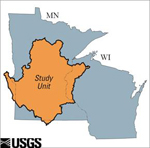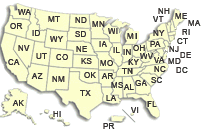
UMIS NAWQA
USGS IN YOUR STATE
USGS Water Science Centers are located in each state.

|
Ground-Water Quality in the Northwestern Twin Cities Metropolitan Area, Minnesota
By Andrews, W.J., Fong, A.L., and Stark, J.R.
Abstract
Published in Proceedings of the 42nd Annual Midwest Ground Water Conference, held at Coralville, IA; October 22-24, 1997.
The U.S. Geological Survey installed and sampled a network of 30 shallow monitoring wells in the northwestern part of the Twin Cities Metropolitan area in Minnesota to evaluate the effects of urban residential and commercial development on ground-water quality. This work was conducted as part of the U.S. Geological Survey's National Water Quality Assessment Program. Wells were drilled during the summer of 1996 in an unconsolidated aquifer, which is developed in terrace deposits lying adjacent to the Mississippi River. Land use in the study area is residential and commercial, development of which has taken place since the 1960's. Water samples from the wells were analyzed for 240 compounds, including physical parameters, major ions, trace metals, nutrients, pesticides, volatile organic compounds, and tritium (from selected wells).
The ground-water samples were generally hard, and contained elevated concentrations of sodium, potassium, and chloride, commonly exceeding 10 milligrams per liter (mg/L). Trace-metal concentrations were generally near or less than reporting limits of 1 microgram per liter (mg/L), but concentrations of iron and manganese commonly exceeded secondary maximum contaminant levels (MCL's) set by the U.S. Environmental Protection Agency. The arsenic concentration in water from one well exceeded the MCL. Nitrate concentrations were greater than 3 mg/L as nitrogen in water from nine wells, and exceeded 10 mg/L in water from one well. Dissolved phosphorus concentrations were generally less than 0.5 mg/L, however, water from one well contained 1.5 mg/L dissolved phosphorus. Pesticides were detected in water from 16 wells, usually at concentrations less than 1.0 mg/L. Prometon, an herbicide commonly used on right-of-ways, was detected in water from 10 wells. Atrazine, a herbicide commonly applied to corn, and
deethylatrazine (a breakdown product of atrazine) were detected in water from six wells and eight wells, respectively. Volatile organic compounds were detected in water from 25 wells, but at concentrations less than 10 mg/L. Tritium concentrations in water from each of the 15 wells sampled exceeded 10 tritium units, indicating that shallow ground water has been recharged since the mid-1950's and that water from most of the wells sampled in the study area should be affected by residential and commercial land uses developed over the past 30 years.
Land uses in the immediate vicinity of the wells significantly affected the frequency of detection and concentrations of some compounds. Concentrations of nitrate, chloride, and frequencies of detection of pesticides and of volatile organic compounds were generally greater compared to concentrations measured in similar aquifers in non-urban areas in the region. Magnesium and sulfate concentrations were greater in areas with more residential development, probably due because those areas are better drained, with greater depths to water affording more opportunity for mineral dissolution in the vadose zone underlying those areas. Concentrations of some pesticides (bromacil, deethylatrazine) and volatile organic compounds (1,1-dichloroethane; 1,1,1-trichloroethane, trichloroethane) were greater in water from wells with greater proportions of industrial and transportation land uses. Ground water in areas with less dense residential development, mostly the more recently-developed areas, tended to have
greater concentrations of nutrients and of agricultural herbicides, which may be relicts of previous agricultural land uses.
|